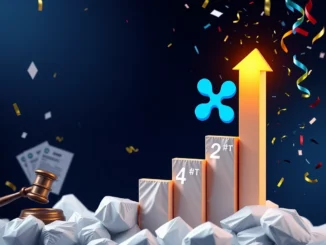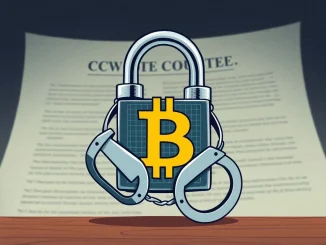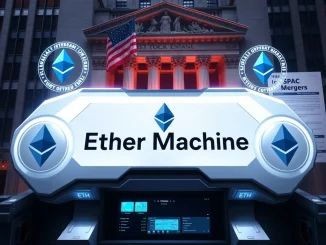
In a stunning turn of events for the crypto world, the U.S. Securities and Exchange Commission (SEC) is reportedly revisiting the classification of XRP, potentially categorizing it as a commodity, much like Ethereum. This pivotal development, first reported by Fox Business’ Charles Gasparino on X, has sent ripples of hope through the XRP community. But what does this mean for the future of XRP and the broader cryptocurrency landscape? Let’s dive into the details of this evolving situation.
The Crucial Question: XRP as a Commodity?
The core of the current discussion is whether XRP, the cryptocurrency associated with Ripple Labs, should be designated a commodity rather than a security. This distinction is not merely semantic; it carries significant legal and regulatory implications. Why is the SEC even considering this now? The answer lies in the ongoing utility and trading status of XRP, and perhaps more importantly, the precedent set by Ethereum.
To understand the gravity of this potential shift, let’s break down the key elements:
- Gasparino’s Report: Charles Gasparino, a senior correspondent at Fox Business, revealed on X (formerly Twitter) that the SEC is actively engaged in internal discussions about re-evaluating XRP’s classification. This report serves as the catalyst for the current wave of speculation and optimism.
- Utility and Trading Status: The SEC’s deliberation hinges on XRP’s current utility and how it’s being traded. Is XRP primarily functioning as a digital commodity, facilitating transactions and network operations, or does it exhibit characteristics more aligned with a security, such as representing an investment contract?
- Ethereum’s Precedent: A significant aspect of this debate is the comparison to Ethereum. Ethereum, like XRP, initially launched through an Initial Coin Offering (ICO) to fund its platform development. Despite this similarity, the SEC never pursued a lawsuit against Ethereum and eventually recognized ETH as a commodity. This precedent is now a focal point in the XRP discussion.
Why is the SEC Considering Commodity Status for XRP Now?
The SEC’s potential shift in stance towards XRP can be attributed to several factors. Firstly, the ongoing lawsuit between the SEC and Ripple Labs has likely provided the commission with a deeper understanding of XRP’s functionalities and ecosystem. Secondly, the successful defense mounted by Ripple, arguing that XRP sales on secondary markets did not constitute investment contracts, may have prompted the SEC to reassess its initial classification. Finally, the established precedent of Ethereum as a commodity creates a comparative benchmark that is hard to ignore.
Let’s consider some key comparisons between XRP and Ethereum that might be influencing the SEC’s considerations:
| Feature | XRP | Ethereum |
|---|---|---|
| Initial Funding | Pre-mined, Distributed | ICO |
| Lawsuit by SEC | Yes (Ongoing) | No |
| Current SEC Stance | Security (in dispute) | Commodity |
| Utility | Payment & Cross-border Transactions | Smart Contracts, dApps, DeFi |
| Trading Status | Widely Traded | Widely Traded |
The Ethereum Comparison: A Ray of Hope for XRP?
The Ethereum comparison is undeniably the elephant in the room. Both XRP and Ethereum utilized initial distributions to fund their development. However, Ethereum managed to avoid the regulatory scrutiny that XRP has faced. The fact that the SEC now views ETH as a fully tradable commodity, despite its ICO origins, is a strong argument for XRP proponents. If Ethereum, with its similar beginnings, is a commodity, why not XRP?
Here’s a closer look at the Ethereum scenario:
- ICO Launch: Ethereum’s development was funded through an ICO, where ETH tokens were sold to investors. This is a model often scrutinized by the SEC as potentially falling under securities regulations.
- No SEC Lawsuit: Despite the ICO, Ethereum was never subjected to a lawsuit by the SEC. This lack of regulatory action is a stark contrast to XRP’s situation.
- Commodity Recognition: Over time, the SEC has implicitly and explicitly acknowledged Ethereum as a commodity. This recognition has been crucial for Ethereum’s growth and widespread adoption.
What are the Potential Benefits of XRP Being Declared a Commodity?
If the SEC were to classify XRP as a commodity, the implications could be transformative for XRP and the crypto industry as a whole. Let’s explore some of the potential benefits:
- Reduced Regulatory Uncertainty: Commodity status would significantly reduce the regulatory uncertainty surrounding XRP. This clarity could attract more institutional investment and foster greater adoption.
- Broader Exchange Listings: Exchanges, particularly in the U.S., might be more inclined to list XRP if it is officially recognized as a commodity, as commodity regulations are generally less stringent than securities regulations.
- Increased Market Confidence: A favorable ruling from the SEC could boost market confidence in XRP, potentially leading to price appreciation and increased trading volume.
- Positive Industry Impact: A commodity classification for XRP could set a positive precedent for other cryptocurrencies facing similar regulatory questions, paving the way for clearer and more consistent regulations within the digital asset space.
Challenges and Considerations Ahead
While the prospect of XRP gaining commodity status is exciting, it’s important to acknowledge the challenges and considerations that remain:
- SEC’s Final Decision: The current discussions are reportedly internal. There is no guarantee that the SEC will ultimately decide to classify XRP as a commodity. The commission’s stance could still shift.
- Ongoing Lawsuit: The SEC’s lawsuit against Ripple Labs is still ongoing, albeit with some positive rulings for Ripple. The outcome of this lawsuit could still influence the SEC’s final decision on XRP’s classification.
- Market Volatility: Even with a favorable regulatory outcome, the cryptocurrency market remains volatile. External factors and broader market trends will continue to impact XRP’s price and performance.
- Future Utility: To maintain commodity status, XRP’s utility and usage will need to remain consistent with commodity characteristics. Any significant shift in its functionality could prompt further regulatory scrutiny.
Actionable Insights for XRP Holders and the Crypto Community
So, what should XRP holders and the broader crypto community take away from this developing situation?
- Stay Informed: Keep abreast of developments regarding the SEC’s deliberations on XRP. Follow reputable news sources and industry analysts for updates.
- Manage Expectations: While the news is positive, avoid excessive speculation. The SEC’s final decision is still pending, and the process could take time.
- Understand Regulatory Nuances: Familiarize yourself with the distinctions between securities and commodities in the context of cryptocurrencies. This knowledge will help you better understand the implications of regulatory decisions.
- Support Industry Advocacy: Engage with and support organizations advocating for clearer and more sensible crypto regulations. Collective action can influence policy decisions.
Conclusion: A Pivotal Moment for XRP and Crypto Regulation
The U.S. SEC’s reported consideration of classifying XRP as a commodity represents a potentially powerful turning point for XRP and the cryptocurrency regulatory landscape. Drawing parallels to Ethereum’s commodity status offers a beacon of hope for XRP and suggests a possible path towards greater regulatory clarity. While the final outcome remains uncertain, the ongoing debate underscores the evolving understanding of digital assets within regulatory frameworks. For XRP enthusiasts and the wider crypto community, this is a crucial moment to watch closely, as it could significantly shape the future trajectory of cryptocurrency regulation and adoption in the United States and beyond.



